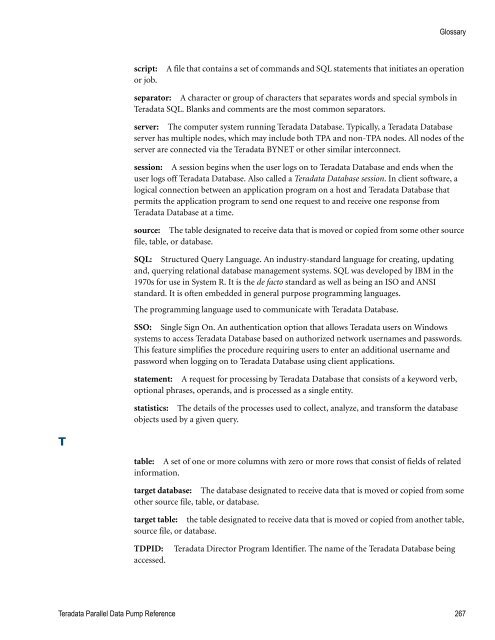Teradata Parallel Data Pump
Teradata Parallel Data Pump Reference - Teradata Developer ...
Teradata Parallel Data Pump Reference - Teradata Developer ...
- No tags were found...
You also want an ePaper? Increase the reach of your titles
YUMPU automatically turns print PDFs into web optimized ePapers that Google loves.
Glossary<br />
script:<br />
or job.<br />
A file that contains a set of commands and SQL statements that initiates an operation<br />
separator: A character or group of characters that separates words and special symbols in<br />
<strong>Teradata</strong> SQL. Blanks and comments are the most common separators.<br />
server: The computer system running <strong>Teradata</strong> <strong>Data</strong>base. Typically, a <strong>Teradata</strong> <strong>Data</strong>base<br />
server has multiple nodes, which may include both TPA and non-TPA nodes. All nodes of the<br />
server are connected via the <strong>Teradata</strong> BYNET or other similar interconnect.<br />
session: A session begins when the user logs on to <strong>Teradata</strong> <strong>Data</strong>base and ends when the<br />
user logs off <strong>Teradata</strong> <strong>Data</strong>base. Also called a <strong>Teradata</strong> <strong>Data</strong>base session. In client software, a<br />
logical connection between an application program on a host and <strong>Teradata</strong> <strong>Data</strong>base that<br />
permits the application program to send one request to and receive one response from<br />
<strong>Teradata</strong> <strong>Data</strong>base at a time.<br />
source: The table designated to receive data that is moved or copied from some other source<br />
file, table, or database.<br />
SQL: Structured Query Language. An industry-standard language for creating, updating<br />
and, querying relational database management systems. SQL was developed by IBM in the<br />
1970s for use in System R. It is the de facto standard as well as being an ISO and ANSI<br />
standard. It is often embedded in general purpose programming languages.<br />
The programming language used to communicate with <strong>Teradata</strong> <strong>Data</strong>base.<br />
SSO: Single Sign On. An authentication option that allows <strong>Teradata</strong> users on Windows<br />
systems to access <strong>Teradata</strong> <strong>Data</strong>base based on authorized network usernames and passwords.<br />
This feature simplifies the procedure requiring users to enter an additional username and<br />
password when logging on to <strong>Teradata</strong> <strong>Data</strong>base using client applications.<br />
statement: A request for processing by <strong>Teradata</strong> <strong>Data</strong>base that consists of a keyword verb,<br />
optional phrases, operands, and is processed as a single entity.<br />
statistics: The details of the processes used to collect, analyze, and transform the database<br />
objects used by a given query.<br />
T<br />
table: A set of one or more columns with zero or more rows that consist of fields of related<br />
information.<br />
target database: The database designated to receive data that is moved or copied from some<br />
other source file, table, or database.<br />
target table: the table designated to receive data that is moved or copied from another table,<br />
source file, or database.<br />
TDPID:<br />
accessed.<br />
<strong>Teradata</strong> Director Program Identifier. The name of the <strong>Teradata</strong> <strong>Data</strong>base being<br />
<strong>Teradata</strong> <strong>Parallel</strong> <strong>Data</strong> <strong>Pump</strong> Reference 267









